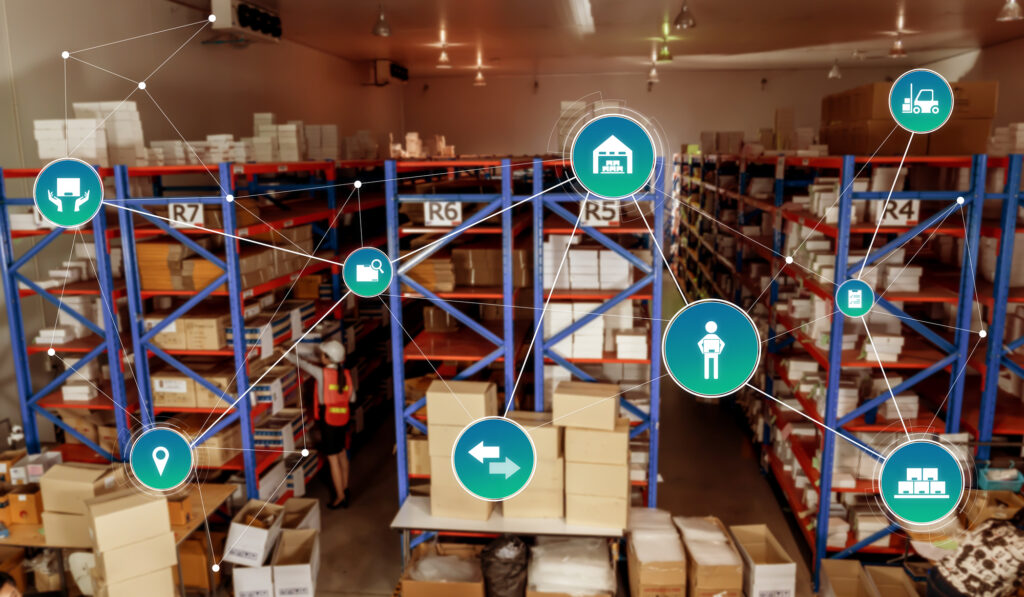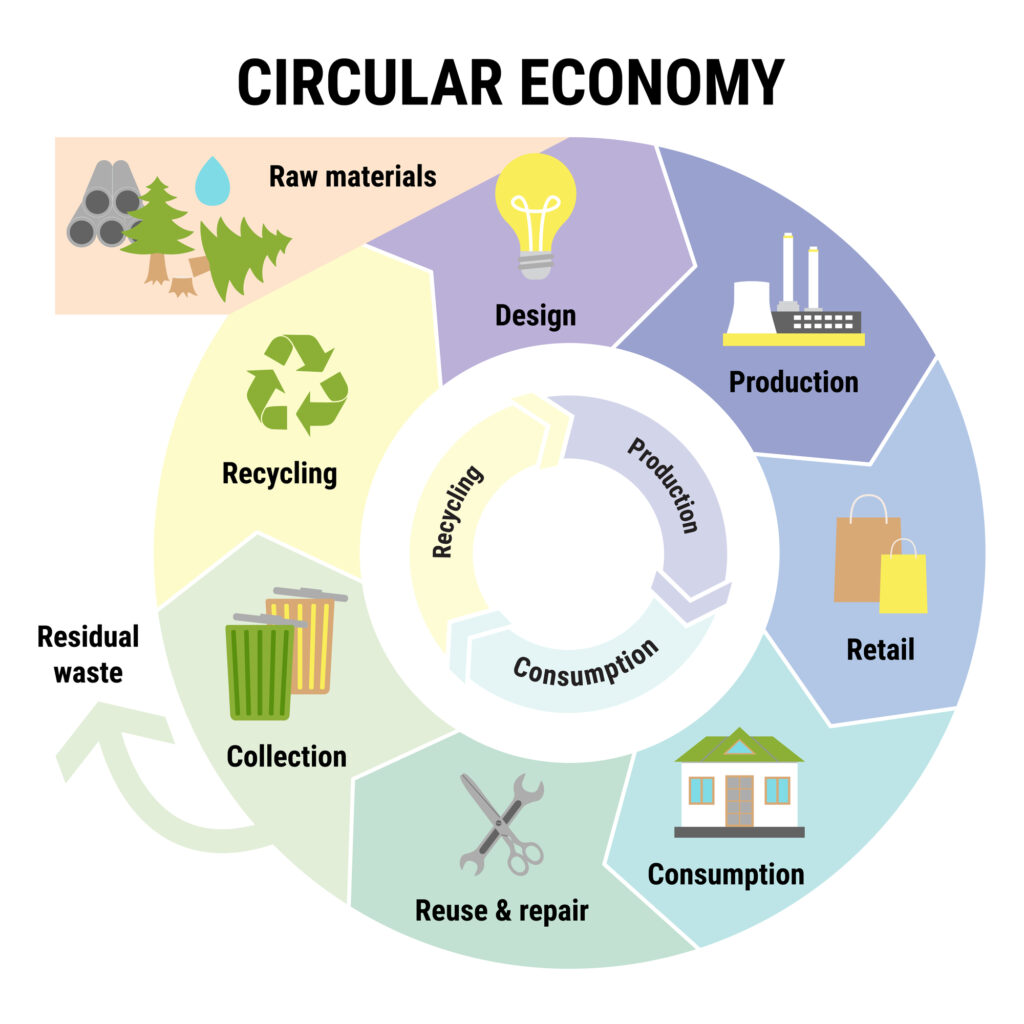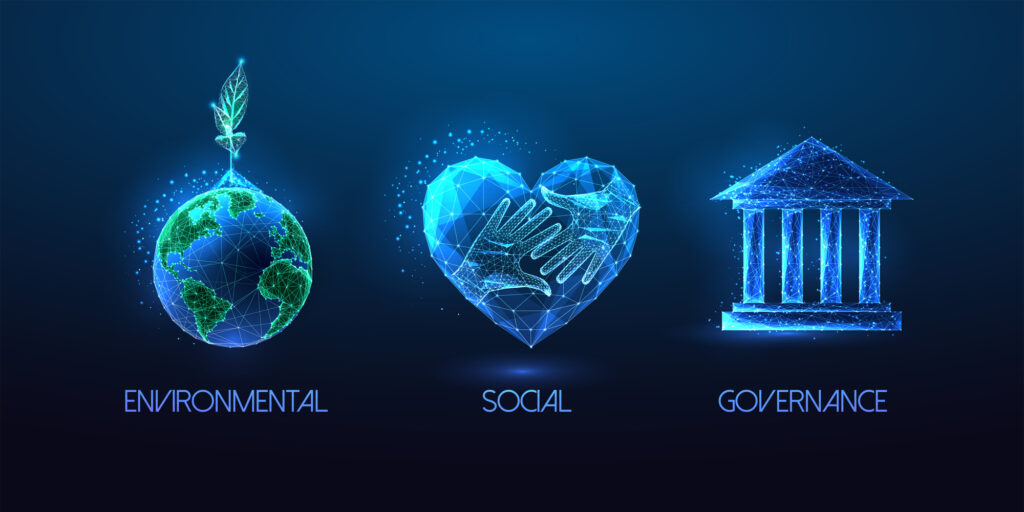
The EU's Digital Product Passport (DPP) is a significant initiative aimed at enhancing transparency and sustainability in product manufacturing and distribution within the European Union.
The DPP framework requires manufacturers and resellers to collect, manage, and share product-related data across a product's lifecycle.
The road to transparency
Through conscious activism, such as boycotting products that conflict with their values, along with the advent of new regulations and the expansive reach of the internet, consumers are becoming more educated and informed about the impacts of waste and the importance of sustainability.
This collective awareness has brought the concept of sustainability to the forefront at every stage of the supply chain, resonating with consumers and senior executives worldwide.
And the backdrop to this change in mindset is set against the world of e-commerce, with its explosive growth driven by the shift in consumer behaviour to buy more online which shows no signs of slowing down.
So, by combining the two mega-trends of sustainability and online shopping, together with an increased awareness of sustainability and the environment, end-consumers are now more than ever, challenging manufacturers over their commitment to corporate sustainability goals.
Our aim with this blog is to explain what DPP is, its role and how using an Master Data Management system can help the roll-out of DPP.
Why do we need the DPP?
The primary purpose of the DPP initiative is to provide consumers and businesses with comprehensive information about the sustainability and environmental impact of products, to help us when we buy a product to make appropriate sustainable choices.
By making this information easily accessible, visible, and traceable the EU aims to facilitate more informed purchasing decisions and encourage sustainable practices throughout the supply chain. Including making it easier to verify compliance with legal obligations.
As businesses share this key product related information, customers will understand more about a particular product’s sustainability and circularity.
There will always be a limit to the amount of resources available for consumption, so it is timely for a shift from the current linear model of consumption out stripping supply to move to a circular economy for a sustainable future.
And this is a shift that is reflected in the B2C (business-to-consumer) market, where the noticeable trend has been one of reducing consumption, with end-consumers buying noticeably less to reduce their consumption habits and environmental impact, along with the fact that the economic conditions today mean people actually have less disposable income.
Globally, by having access to the DPP data, it can be leveraged to help businesses make the transition to a circular economy. Data that can be applied to boosting efficiencies, learning how to extend a product's lifetime through optimised design, manufacturing, and end of life handling.
The European Commission (EC) is the first large regulator aiming for mandatory DPP implementation across a range of products and industries. The EC hopes to reach the final approval of the Eco-design for Sustainable Products Regulation (ESPR), that includes the DPP, in 2024.
Research shows (Digital Product Passport in the textile sector) that the current corporate practices could be encouraged to do more, and the use of DPP would enable more transparency and encourage more sustainable uses and circularity.
Read more: How can retailers make product data accessible on channels their customers use?

How does DPP apply to my business?
Sustainability and transparency are becoming ever more important when it comes to influencing the buying behaviour of consumers. So, businesses need to apply themselves to these new initiatives that enhance consumer trust and promote environmental responsibility.
The common thread between 2023 and 2024 has been that end-consumers are demanding a more responsible approach by manufacturers to reduce waste. Consumers are keen to see brand owners take responsibility and respond to their demands in an appropriate way rather than just tell them what they think they want to hear with “green washing”, i.e. spending more resources on advertising being "green" than on environmentally sound practices that have an impact.
The EU's DPP is one such initiative that aims to improve product sustainability by making manufacturers and resellers collect, manage, and publish detailed information about their products.
The main advantage of the DPP is that it goes beyond a simple label. Thanks to the information it contains, this tool has the power to overcome the lack of data associated with a product, an obstacle that has so far hampered the repair, recycling and reuse processes.
Thanks to the data contained in the DPP, it will be easier to repair products by identifying them and accessing specific maintenance or repair services to order spare parts.
In addition, the new functionality-related circular economy models can use the DPP to collect information during the use phase of the product, such as a history of maintenance, repairs, rentals and resales, right up to the end of the product's life.
To date, product traceability has generally been limited to the supply chain up to the point of sale to the consumer. The DPP opens up new horizons by recording events that occur after the initial sale of the product, opening up new sources of data collection, providing a better understanding of customer behaviour and usage. This information can also be used to improve existing products and create new services, extending the useful life of products.
Producers have a responsibility to anticipate what will happen to their products at the end of their life. This is the purpose of Extended Producer Responsibility (EPR) compliance reporting, to gain visibility to end-of-life costs which can then be applied during the product design stages.
This type of reporting can help identify circular economy opportunities and measure the impact of their adoption throughout the product lifecycle. This data can then be used to reduce the impact of having to recycle at end-of-life for a product by making better, more sustainable decisions at the product design stage. Decisions that could make it easier for products to be reused or recycled, and effectively reduce long term costs.
The DPP information could also be leveraged to communicate more effectively the recycling rate or actual product lifetime if the products can be scanned at the sorting centre.
The DPP provides a superior level of information that can appeal to demanding customers and create a better and more informed user experience. Brands know that sustainability is an attribute that customers value, and are therefore striving to promote product transparency, tapping into customer concerns.
With so much information to process and manage, it makes sense for businesses to deploy a robust Master Data Management (MDM) solution.

So, how can having an MDM solution help?
The first step towards DPP compliance is for a company to gather detailed product information and get it in order. So, companies will need a powerful data collection framework that enables them to capture and consolidate all relevant data points.
Managing product data across multiple systems and departments can be a complex and error-prone process. Using an MDMs centralised data management capabilities can bring together diverse data sources as a single source of truth, enabling businesses to have a holistic view of their product information, facilitating compliance with DPP requirements and identifying knowledge gaps that might slow down the path to compliance.
Read more: How to use Stibo STEP to unlock value in the CPG sector
Maintaining data quality and governance is crucial for DPP reporting to be accurate and up to date. An MDM system can offer a robust data management tool, defining clear processes for data collection and storage, facilitating data validation, cleansing, and the application of data standards.
An MDM solution can also publish product data to the appropriate channels, alerting suppliers about new transparency requirements and ensuring that the relevant product information reaches the intended audiences accurately and efficiently.
Read more: How B2B Distributors can successfully leverage MDM
Book a free consultation and let’s explore how we can help you leverage MDM to meet DPP requirements in your organisation.

The implementation of the Corporate Sustainability Reporting Directive (CSRD) mandates that European companies of a particular size must report their Environmental, Social, and Governance (ESG) information.
According to McKinsey, “... while more than 95 percent of S&P 500 companies issue a sustainability report, very few fully integrate environmental, social, and governance (ESG) into their equity stories…”
ESG can be described as a set of practices (policies, procedures, metrics, etc.) that organisations may use in order to limit the potential negative impact on the environment, society at large, and their organisation from carrying out their business.
Recently ESG has become a hot topic because the first reporting cycle from businesses will be due in 2025, based on data from financial years starting on or after 1 January 2024.
Investors are also keen to find proof points that the companies that they invest in are delivering on their ESG strategy, generating the desired results or that they are proactively addressing ESG.
As organisations now are starting to really dig into the ESG reporting obligations, this article will help highlight how Master Data Management (MDM) can become an integral part of enabling organisations to meet their ESG reporting needs.

What is MDM?
A Master Data Management or MDM solution can be applied by enterprise organisations to manage their most critical data assets (known as master data) and is often referred to as the “single source of truth”. A single source of truth for collecting data, simplifies decision-making processes, building trust amongst stakeholders because everyone knows they can rely on the same dataset for accurate, reliable information.
An investment in MDM should be regarded as a building block on which subsequent business initiatives can be built, based on access to trustworthy data that facilitates effective business decisions.
The success of an MDM initiative for ESG reporting will hinge on securing commitment and endorsement across your organisation from key stakeholders. And to get the necessary stakeholder buy-in, you’ll need to be able to demonstrate the added value that can be achieved by leveraging MDM to successfully deliver your ESG reporting.
What are the ESG reporting needs that an MDM solution would help address?
MDM as the single source of truth, is an effective mechanism to collect and integrate ESG data from your various internal and external sources. At the same time, its structure can be used to help you define and implement validation rules and data cleansing procedures to identify and rectify errors, inconsistencies, and redundancies in the data before they can impact your reporting.
MDM systems can be an integral part of pulling together processes that ensure compliance with regulatory standards, helping to develop data security protocols and privacy measures to protect sensitive ESG data.
By harmonising ESG data across the many different sources and systems, organisations can generate comprehensive insights that on reflection will help them to identify emerging trends, and assess performance against their ESG goals and targets.

So - what are the steps that you should be taking to implement an MDM solution?
Step 1 - Planning
The first step to consider when implementing an MDM solution for ESG reporting involves comprehensive planning, to prepare a solid foundation from which the MDM system can be leveraged.
In order to create an effective plan, it's essential to gain a deep understanding of the scope of an organisation's ESG reporting needs and objectives. This entails identifying the specific ESG metrics that need to be tracked, as well as flagging and involving key stakeholders and resources for their input.
Planning also involves conducting a thorough assessment of existing ESG data sources, understanding the format and structure of the data. By mapping out the existing data ecosystem, organisations can identify potential gaps, inconsistencies, and redundancies that need to be addressed during the MDM implementation process.
Step 2 - Design
During the design phase, as well as discussing how to make reporting intuitive so that performance can be visualised and analysed effectively - it is also a time to translate an organisation's ESG reporting needs into a structured MDM solution. This includes determining the data model, which defines the types of ESG data to be captured, such as environmental metrics (e.g., carbon emissions, water usage), social indicators (e.g., diversity, labour practices), and governance practices (e.g., corporate policies, board structures).
The design process involves establishing data governance policies and procedures which includes defining data ownership, access controls, and data stewardship roles to ensure the integrity, security, and compliance of ESG data.
An MDM solution needs to be flexible to be able to adapt to changing business needs and technological advancements and scalable to ensure that the system can accommodate future growth and evolving ESG reporting requirements.
Step 3 - Building
Once the design is complete, organisations transition to the building phase, where they translate the design specifications into tangible components of the MDM solution.
This phase involves the development and configuration of data integration processes, data cleansing routines, and data enrichment mechanisms to ingest, harmonise, and manage ESG data from diverse internal and external sources.
Building an MDM solution may also need some customisation or system configuration to address unique organisational requirements and compliance standards in a particular vertical.
Step 4 - Testing
Organisations conduct various levels of testing, including unit testing, integration testing, and user acceptance testing, to identify and rectify any defects or issues.
Data quality checks, validation rules, and adherence to ESG reporting standards are rigorously evaluated during this phase to ensure the accuracy and consistency of ESG data.
Step 5 - Deployment
Following successful testing and validation, the MDM solution is ready for deployment into the production environment. Deployment involves executing data migration processes, configuring system settings, and conducting training sessions with users.
After a successful MDM implementation there is also a need to maintain ongoing monitoring, support, and optimisation of the solution with regular updates and assessments of how the system is performing.
Check out our video series on How To Get Started on Your MDM Journey.

Integrating ESG and MDM, what are the benefits?
By integrating ESG and an MDM solution, it ensures that the ESG data will be governed by consistent quality standards and validated through robust data management processes.
Plus, by automating data workflows within the MDM framework, it can reduce the manual effort required for tasks and minimises the risk of errors or inconsistencies in ESG reporting.
Enhanced data quality and integrity come from centralising ESG data within an MDM framework, organisations can then establish their data governance policies, implement their data validation rules, and enforce data quality controls to make sure that their ESG data is accurate and complete.
By establishing a common understanding internally of ESG metrics, organisations can foster collaboration between the various stakeholders, building credibility and trust, that a business is committed to ESG transparency and accountability.
Is ESG part of your corporate strategy?
Integrating ESG considerations into your corporate strategy requires a structured approach that aligns ESG principles with the organisation's overarching goals and values.
And the main starting point for most organisations is in defining their ESG vision and mission, communicating the organisation's long-term aspirations and values to internal and external stakeholders.
Next Steps
Not all aspects of ESG however, are priorities for all organisations, and it is unrealistic to expect that as a business that you’ll not have to make trade-offs within and among the various ESG dimensions, or that they can be an industry leader on every topic.
So, get in touch to have a conversation about rolling out an MDM solution for your ESG reporting.
Achieving success with your MDM project requires a lot of preparation. There are many things to consider and it can be hard to figure out where to start especially with this new legislation around CSRD.
Book a free consultation call with us today to learn more about how we can help.

As organisations prepare to meet the growing demands of Environmental, Social, and Governance (ESG) reporting in 2024, this article highlights the significance of Master Data Management (MDM) as the cornerstone for compiling ESG reporting.
We will delve into the essentials of ESG reporting, and the role of MDM in helping to streamline the data governance processes. Moreover, discover the benefits and challenges of ESG reporting, the importance of a data-first approach, and practical strategies for leveraging MDM to empower ESG initiatives.
Background
The Corporate Sustainability Reporting Directive or CSRD entered into force on 5th January 2023, with EU Member States required to implement its provisions into national law and regulation by 6th July 2024.
The CSRD was a new piece of EU legislation concerning the social and environmental information that companies have to report, with the aim to address the disparity between investors’ information needs and the corporate sustainability information that is available. The first reporting cycle is due in 2025 based on data from financial years starting on or after 1 January 2024.
For the first three years, the application of the requirements will be on a “comply or explain” basis, because for many companies not all the necessary information regarding their entire value chain is going to be readily accessible.
So, as companies start to build their data foundations in anticipation of upcoming reporting and disclosure requirements they must be able to detail the efforts made to obtain the necessary information, reasons why it cannot be obtained and their plans going forward to obtain the information.
The CSRD directive will directly impact large companies (estimated 50,000+), as well as listed SMEs (Small and Medium sized Enterprises), who will now be required to report on sustainability. The directive however does exclude “micro” companies, those with less than 10 employees or below EUR 20 million in turnover.
Read more: Why Master Data Management should become the foundation for ESG reporting.

ESG – what it is and why it matters
ESG stands for “Environmental, Social and Governance.” ESG can be described as a set of practices (policies, procedures, metrics, etc.) that organisations implement to limit the negative impact of their business on the environment, society at large, and governance bodies.
So fast forward to 2024 and investors are increasingly looking for companies that prioritise sustainability and ESG considerations to guide their investment decision-making. As a result, many businesses have begun to integrate ESG into their operations and business strategies.
When an organisation is implementing ESG, for each element where is the focus?
In regards to ESG reporting, Environment focuses on a company’s adherence to pertinent regulations and their environmental footprint; Social encompasses a company's impact on society at large and its stakeholders (employees, customers, communities, suppliers, and other parties), and Governance relates to the internal systems and structure of corporate decision-making, oversight, and accountability that will be reported on.
Executing ESG reporting demands accurate and comprehensive data across multiple dimensions and sources, so a Master Data Management (MDM) system is an ideal structure to provide the necessary framework to ensure data integrity and consistency.
By implementing MDM, an organisation has the tools to create most importantly a single source of truth for its data. Using MDM to facilitate data collection, cleansing, and standardisation to ensure that the reported data is reliable, trustworthy, and meets regulatory compliance.
Read more: What is the expected financial impact of investing in your Master Data Management (MDM)?
What are the benefits and challenges of ESG reporting for organisations?
Companies subject to the CSRD directive will have to report according to the European Sustainability Reporting Standards (ESRS). The CSRD also makes it mandatory for companies to have third-party assurance and external auditing of the sustainability information that they report.
The new EU directives will ensure that investors and other stakeholders have access to the information they need to assess investment risks and will also create a culture of transparency about the impact of companies on people and the natural environment.
How to understand and identify your ESG data
There are a number of different types and sources of ESG data that organisations need to collect and report on, we list a few of the major ones below.
For ESG, Environmental data includes metrics such as carbon emissions, water usage, waste management and pollution prevention, energy consumption, renewable energy usage, and biodiversity impact. This data helps stakeholders understand an organisation's environmental footprint and its efforts towards conservation and sustainability.
Secondly, Social data evaluates how a company manages its relationships with its stakeholders i.e. the workforce, communities, and broader society. This includes information on labour practices, diversity, human rights, community engagement, health and safety standards, privacy protection and product safety and quality. By reporting on social metrics, organisations demonstrate their commitment to employee welfare, respect for human rights, and positive contributions to the communities in which they operate.
Thirdly, Governance focuses on a company's internal controls, transparency, business ethics, and practices that guide decision-making and oversight within the organisation. Through governance data, organisations showcase their commitment to accountability, integrity, and transparent corporate governance practices.
Read more: What Is Stibo STEP & How Can It Help Your Business?
As a business understanding your ESG priorities
What can be confusing for an organisation is to understand what ESG issues could potentially impact their business operations, reputation, and long-term sustainability the most.
So, they adopt a materiality assessment, a process to prioritise and focus efforts on those issues that have the greatest potential to influence the organisation's performance and stakeholders' perceptions.
With this materiality criteria an organisation can then prioritise ESG issues that serve as the focal points for developing strategies, setting targets, and implementing ESG initiatives.
Taking a collaborative approach also with stakeholders through for example consultations and surveys, provides valuable insights into stakeholder interests and needs. And by embedding ESG metrics into key performance indicators (KPIs) and reporting frameworks, organisations drive accountability and transparency throughout their operations.
Organisations need to identify internal and external sources of ESG data, extensively mapping the data sources and establishing robust data governance processes to ensure accessibility of ESG data across the organisation.
Read more: How to Get Started on Your Master Data Management (MDM) Journey.

Taking a data-first approach to ESG reporting
The importance of a data-first approach to ESG reporting lies in its ability to enhance the credibility and trustworthiness of the reported information reducing the risk of misinformation or misinterpretation.
Accurate and reliable ESG data provides stakeholders with a clear and comprehensive understanding of an organisation's environmental and social impacts, as well as its governance practices.
Accurate data also enables organisations to benchmark their performance against industry peers, track progress over time, identify trends and demonstrate continuous improvement in ESG performance.
How to use MDM to empower your ESG initiatives
One of the key roles of MDM in ESG reporting is to facilitate data governance with rules, standards, and workflows for managing ESG data throughout its lifecycle. MDM ensures that ESG data is captured, validated, and updated consistently across various business processes and systems, thus enhancing data quality and integrity.
With a single source of truth for ESG data, an MDM system can generate comprehensive and reliable reporting and disclosures that meet the needs of internal and external stakeholders.
MDM enables an organisation to create a centralised repository or data hub for ESG data, which can then serve as a single source of truth across the organisation. By consolidating disparate data sources and establishing a unified data model, MDM ensures that ESG data is consistent regardless of its origin or format.
An MDM system allows an organisation to implement data quality controls and validation checks, and enforce data privacy and security protocols to ensure the integrity and confidentiality of ESG data organisation wide.
Moreover, MDM facilitates data integration and enrichment, streamlining the process of aggregating, and reconciling ESG data from various sources internal and external, and by uncovering deeper insights enabling more accurate and comprehensive analysis and reporting.
Conclusion
In summary, MDM acts as the foundation for compiling ESG reporting by ensuring data accuracy, integrity, and consistency across the organisation, enabling organisations to meet what will be going forward the growing demands of ESG reporting in an efficient and effective manner.
Next Steps
Get in touch to roll out MDM for your ESG reporting.
Achieving success with your MDM project requires a lot of preparation. There are many things to consider and it can be hard to figure out where to start especially with this new legislation around CSRD.
Book a free consultation call with us today to learn more about how we can help.

The principles of a circular economy revolve around products and systems that should be designed with the intention of maximising their lifecycle and facilitating reuse, repair, and recycling.
Which sounds like an approach any self-respecting business would be keen to adopt and adhere to - but, in effect designing out waste and promoting a regenerative and sustainable economic system is not as easy as it sounds.
Giving up an ingrained approach to manufacturing that has been successful for decades involves selecting materials and components that can be easily disassembled, and shifting to a “circular” way of thinking that encapsulates the entire product lifecycle from production to disposal.
At the moment, estimates suggest that only 8.6% of the world’s economy is circular. Globally we have historically followed a linear economy in which finite resources are extracted to make products that are used - generally not to their full potential - and then thrown away or known as the 'take-make-waste' model.
There are a number of industries however that are actively participating in designing products for maximum lifecycle and incorporating principles of reuse, repair, and recycling.
The "take-make-waste" model
Moving away from a "take-make-waste" model, the circular economy focuses on extending the lifespan of products through repair, refurbishment, and remanufacturing. It also encourages the introduction of product sharing, rental, or leasing models to maximise their useful life.
There are companies and governments actively embracing circular economy principles and implementing strategies to extend product lifespans and maximise resource utilisation.
However, making that transition from a linear to a circular economy has a profound impact on data management. To successfully navigate this shift, businesses must adapt their data strategies to meet the unique demands of circular economy principles.

Data is the lifeblood of the circular economy.
The circular economy involves tracking products throughout their entire lifecycle, from production to disposal, ending up recycled or as a component in remanufacturing. This flow significantly increases the volume and complexity of data that organisations need to manage.
Those data sources can quickly expand to include product usage data, repair records, recycling statistics, and more. And this is where MDM (Master Data Management) can help businesses make informed decisions regarding the circular economy.
Today, there are a number of different progressive industry verticals that are actively following a circular economy, in conjunction with managing the growing complexities of data management they now face.
Industries adopting a circular economy

Retail
Patagonia have for example implemented a take-back programme for their products, allowing customers to return used items for repair, resale, or recycling. They utilise data to track the quantity and types of garments returned, the lifecycle of products, identify repair needs, and measure the environmental impact of their operations.
This data helps them understand the volume of clothing being recycled, track trends, and optimise their recycling processes. They want to be able to use the data to identify the most effective methods for recovering and reusing materials so that they can incorporate recycled materials back into their production processes, reducing the need for new resource extraction.
Without a solution in place, according to Patagonia, global textile waste is expected to increase 60 percent annually until 2030, when it’s estimated to hit 148 million tons per year.
Clothing brands like H&M are embracing sustainable fashion practices. They design clothing made from durable materials that will last, offer repair services, and implement garment take-back initiatives for recycling.
Data is used to track material usage, analyse consumer behaviour, and identify opportunities for material recovery and circular fashion solutions.
To implement circularity effectively, retail businesses must be able to trace the flow of materials, products, and components in both forward and reverse supply chains. This requires an approach to capture the origin, composition, and history of each item.
Full transparency of the supply chain is essential to verify sustainable sourcing, especially if that is an integral part of the sales and marketing message of these retail brands.
Plus, data can be used to analyse product lifecycles, track customer feedback, and optimise recycling and remanufacturing processes.

Electronics
Dell have established initiatives for recycling and refurbishing electronic devices. They collect used products, disassemble them, recover valuable components, and either refurbish and resell them or recycle the materials.
They use the data they collect to capture product information, track product returns, identify opportunities for refurbishment, and ensure responsible disposal of electronic waste.
Most importantly, data is used to assess the environmental impact of their recycling and refurbishment initiatives from energy consumption, emissions, and waste generated during these processes to how they perform against sustainability goals.
By analysing data on what are particular device failures, repair requirements, and a components lifespan, Dell can identify opportunities for product improvements, enhanced durability, and extended lifecycles.
Dell uses data to identify valuable materials present in electronic devices, such as metals, plastics, and rare earth elements. This information helps them optimise recycling methods and recover valuable resources efficiently.

Automotive
Car manufacturers such as Toyota and Ford are incorporating design elements that enhance product longevity and recyclability. They use modular designs, prioritise the use of recyclable materials, and establish take-back programmes for end-of-life vehicles.
Data plays a part monitoring component usage, analysing product performance, and optimising recycling processes.
Volvo have been offering remanufacturing for 70 years, developing the processes to extend the lifecycle of parts and components. Remanufacturing gives a product or component a new life.
Remanufacturing can be used to short-cut the complexity of value chains of parts, leading to significantly lower material and energy usage compared to a new part, made to the same high-standards. The Volvo remanufacturing programme mainly operates with engines, filters, gearboxes and rear-axle transmissions.
Volvo utilises the data it gathers to assess the condition of returned parts, analysing data on a components usage, failure rates, and performance. Combining this data helps it determine which parts can be effectively remanufactured and how to extend the product lifecycle.
And after remanufacturing, Volvo is keen to collect data on performance to ensure that these parts meet or exceed the same high standards as new components. This helps maintain customer satisfaction and confidence in the remanufacturing process.
By comparing the costs of remanufacturing versus manufacturing new parts, Volvo can evaluate the financial viability of their remanufacturing initiatives. This data-driven approach helps optimise cost structures and ensure the economic sustainability of their remanufacturing operations.

What is MDM and how do businesses use it?
Master Data Management (MDM) is a discipline and a set of processes and technologies used by organisations to manage their critical business data (known as master data).
By centralising and standardising their data through an MDM strategy, businesses can ensure that everyone is working with and has access to the same information across the organisation.
How can an MDM solution help these industries use data in various ways to support their circular economy initiatives?
Centralisation
By centralising and analysing product data, businesses can pinpoint inefficiencies and develop strategies for minimising waste, improving resource utilisation, and extending the lifespan of a product. This optimisation process can lead to cost savings and reduce the environmental impact of materials.
In addition, tracking the entire product lifecycle helps identify opportunities for repair, refurbishment, recycling, or remanufacturing.
Key Performance Indicators (KPIs)
An MDM solution can support businesses in monitoring and measuring key performance indicators (KPIs) relevant to the circular economy.
By capturing and analysing data on resource efficiency, waste reduction, product reuse, and recycling rates, businesses can track their progress, set targets, and generate reports to demonstrate their commitment to circular economy principles.
This data-driven reporting can enhance stakeholder engagement and attract environmentally conscious customers and investors.
Fostering collaboration
MDM solutions can enable collaboration and integration across business ecosystems.
By sharing standardised data with suppliers, customers, and partners, businesses can work harder on delivering on circular economy initiatives such as sharing resources and recovering materials. This collaboration enhances the overall effectiveness and impact of circular economy practices.
Supply chain optimisation
Data can be used to optimise supply chains, identify inefficiencies, reduce waste, and improve resource allocation. This includes tracking materials, components, and products throughout the value chain, providing end-to-end traceability and transparency across the entire chain.
Unit of Measure, experts in STEP
Supporting a circular economy initiative is only one out of many business benefits of Master Data Management. If you are ready to get started with MDM, we here at Unit of Measure are here to help you. We recommend the MDM platform STEP developed by Stibo Systems, which is a tool that can help you make the most out of your business data to achieve your business goals.
At Unit of Measure we have more than 20 years of experience in implementing STEP for large global enterprises with complex requirements and our STEP experts are here to make your MDM journey simple and smooth.
Get in touch to roll out MDM for your business, improve data quality and governance, increase efficiency and revenue, and gain valuable insights for better decision making.
Book a free consultation call with us today to learn more about how we can help.

Master Data Management (MDM) will play a pivotal role in helping larger organisations compile and collate the necessary data that is required to fulfil the new European Union’s ESG (Environmental, Social, and Governance) impact reporting directive, slated to take effect for the 2024 financial year.
The change in having to publish findings on a company’s impact across the ESG elements will affect 50,000+ organisations who will be required to detail how their business strategy will mitigate the risks associated with the ESG issues and figures that they disclose in their reporting.
What are the ESG elements that companies will have to report on?
In regards to ESG, each element in the required reporting would need to be addressed and data provided on the following:
Environment: This focuses on a company’s adherence to environmental regulations and the impact they have on the natural environment; from factors such as carbon emissions, to energy consumption, pollution prevention, water and marine resources, biodiversity, resource conservation, waste management, renewable energy and efforts towards mitigating climate change.
Social: This encompasses a company's impact on society at large and its stakeholders (employees, customers, communities, suppliers, and other parties), evaluating how a company manages its relationships with those affected by its operations. Social factors include employee welfare, labour standards, diversity and inclusion, human rights, community engagement, product safety, customer satisfaction, privacy protection, and social contributions.
Governance: The internal systems and structure of corporate decision-making, oversight, and accountability will be reported on. Focusing on a company's internal controls, transparency, business ethics, and effectiveness of the board. Key governance factors include board composition, executive compensation, shareholder rights, risk management, anti-corruption measures, disclosure practices, and adherence to legal and regulatory requirements.

New CSRD regulations means ESG reporting for many more companies in Europe
In early 2023, the Corporate Sustainability Reporting Directive (CSRD) entered into force. This was a new piece of European Union legislation, a directive created to modernise and strengthen the current rules concerning the social and environmental information that companies have to report.
The CSRD directive will directly impact large companies, as well as listed SMEs (Small and Medium sized Enterprises), who will now be required to report on sustainability. The directive however does exclude “micro” companies, those with less than 10 employees or below EUR 20 million in turnover.
Updating existing reporting directives in the EU
The CSRD aims to strengthen and extend the scope of the existing EU reporting requirements from its predecessor, the Non-Financial Reporting Directive (NFRD) that had impacted 11,700 companies, based on a much larger business size criteria for inclusion.
Companies subject to the CSRD will have to report according to European Sustainability Reporting Standards (ESRS). The CSRD also makes it mandatory for companies to have third-party assurance and external auditing of the sustainability information that they report.
In 2022, the European Financial Reporting Advisory Group (EFRAG) released its first draft of the ESRS reporting standards, which will fall under the CSRD.
Within the reporting standards the CSRD values sustainability metrics alongside environmental performance, with a special focus on how organisations monitor their social impact, such as employee health, human rights, bribery, anti-corruption and diversity. And there are several data-intensive disclosures within the ESRS covering greenhouse gas emissions, energy, waste, water, recycling and social metrics.
Why focus on reporting ESG?
The new EU directives will ensure that investors and other stakeholders have access to the information they need to assess investment risks arising from climate change and other sustainability issues. They will also create a culture of transparency about the impact of companies on people and the environment.
The first companies who will have to apply the new reporting rules will do so on their 2024 financial year data, for reports published in 2025.
Existing legislation such as the EU's Non-Financial Reporting Directive (NFRD) had already set out rules for the disclosure of non-financial information by certain large and listed companies. Companies that are already subject to the NFRD will need to report on their 2024 data.
As ESG considerations gain prominence globally, organisations impacted by the EU’s CSRD announcement need to start building their data foundations in anticipation of upcoming reporting and disclosure requirements.
Longer term, the intended outcomes of CSRD will contribute to Europe’s 2050 climate-neutrality target, and European Green Deal objectives.

What is the connection between the DPP and ESG reporting?
The EU's Digital Product Passport (DPP) and ESG reporting are interconnected as they both contribute to sustainable practices and transparency within organisations.
The DPP is a digital framework that requires a manufacturer or reseller to gather detailed information on their product's environmental impact, its lifespan, and repairability. The DPP initiative aims to enhance sustainability by promoting resource efficiency, circular economy principles, and the reduction of waste.
Companies will need to source data for the DPP on a product's material composition, energy consumption, carbon footprint, and other relevant information.
When it comes to the ESG elements, the DPP feeds into the reporting its environmental data around a products’ sustainability attributes and progress towards sustainability goals.
By linking the DPP with ESG reporting it can help stakeholders evaluate a company's environmental performance and make informed decisions based on the disclosed information.

So, how can having an MDM system help?
As ESG reporting requires accurate and comprehensive data across multiple dimensions, MDM provides the necessary framework to ensure data integrity and consistency.
By implementing MDM, organisations can centralise and govern their ESG data, creating a single source of truth. MDM facilitates data collection, cleansing, and standardisation, ensuring that information from various sources aligns with reporting requirements.
Having an MDM structure enables organisations to establish data quality rules, validate data against predefined criteria, and resolve any inconsistencies.
MDM also helps in linking and harmonising data from diverse systems, enabling a holistic view of ESG metrics. It ensures that the reported data is reliable, trustworthy, and meets regulatory compliance.
In summary, MDM acts as the foundation for compiling ESG reporting by ensuring data accuracy, integrity, and consistency across the organisation, enabling organisations to meet the growing demands of ESG reporting in an efficient and effective manner.
If you want to learn more about how to get started, book a free consultation and let’s explore how we can help you get the most from your MDM investments when compiling your ESG reporting.